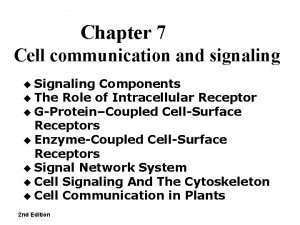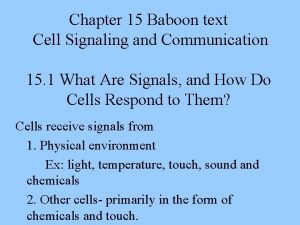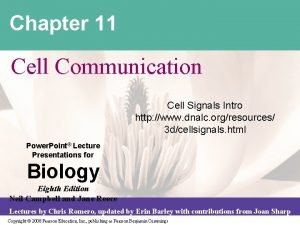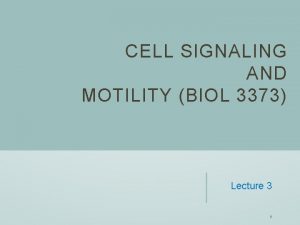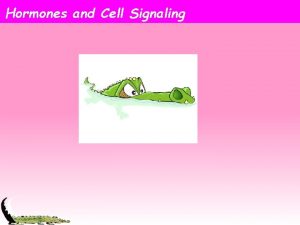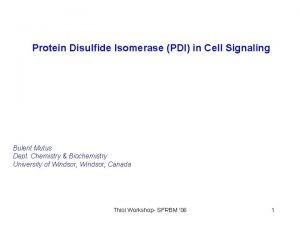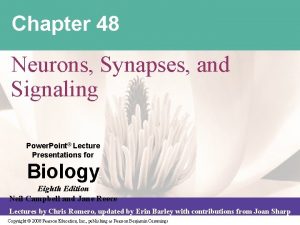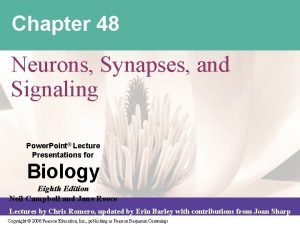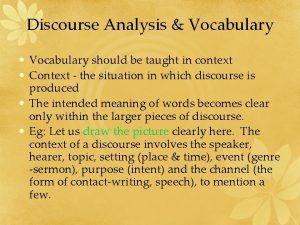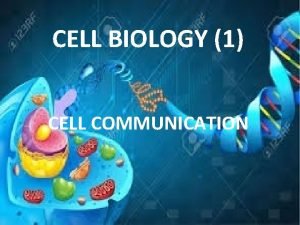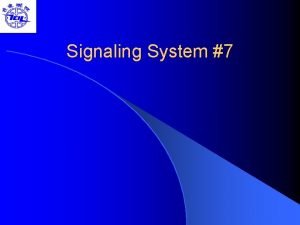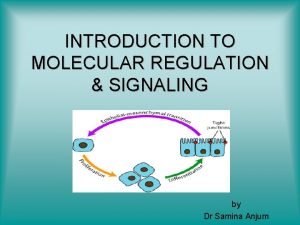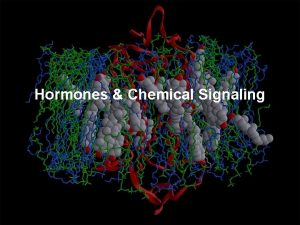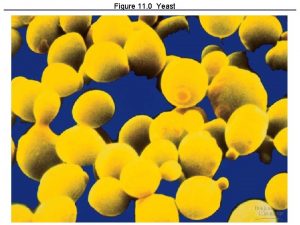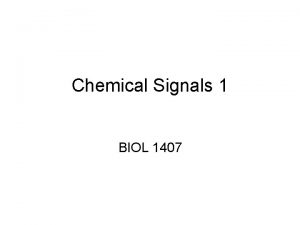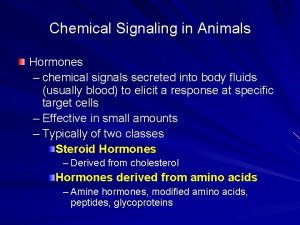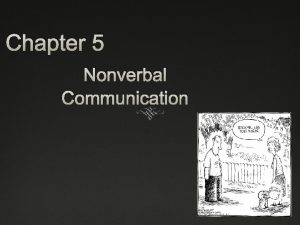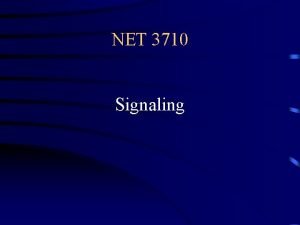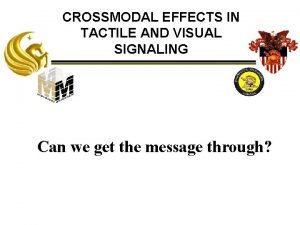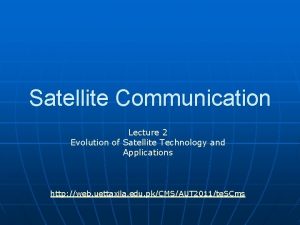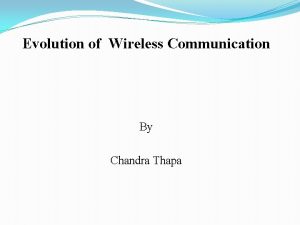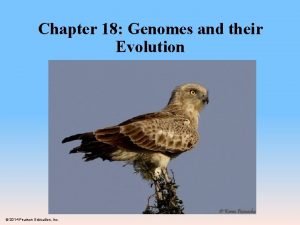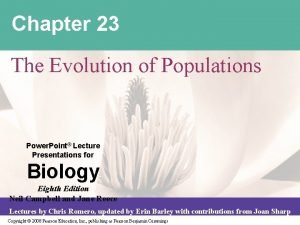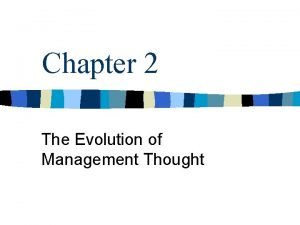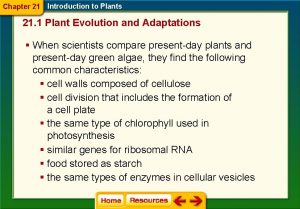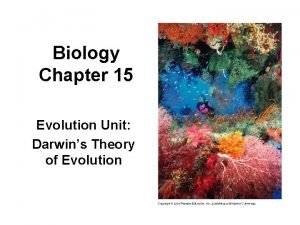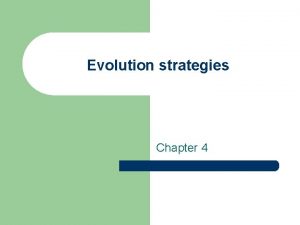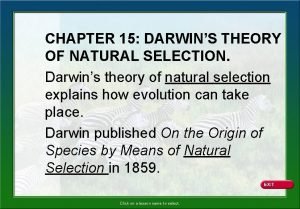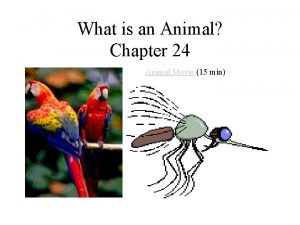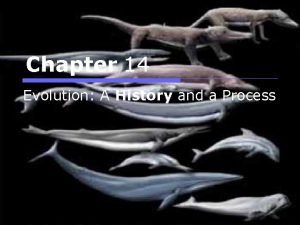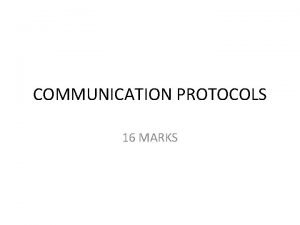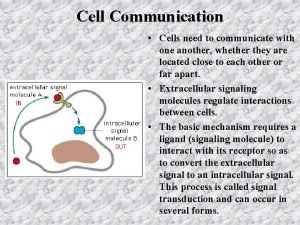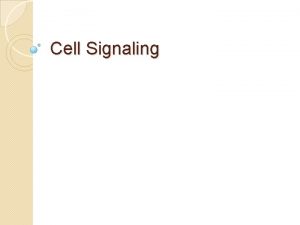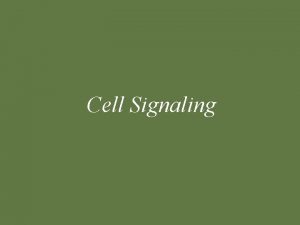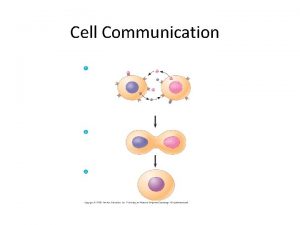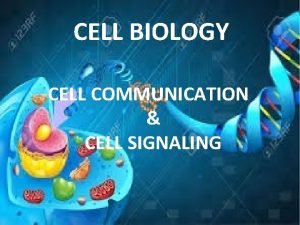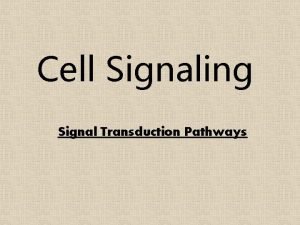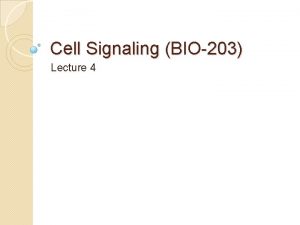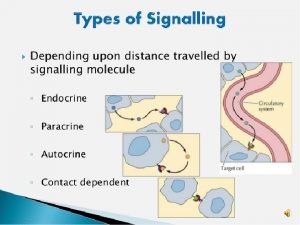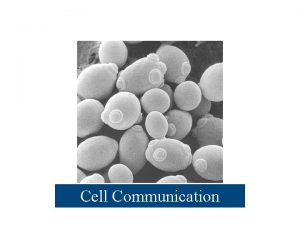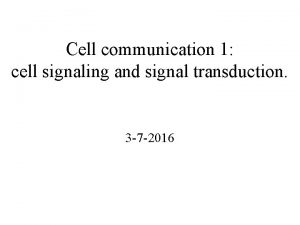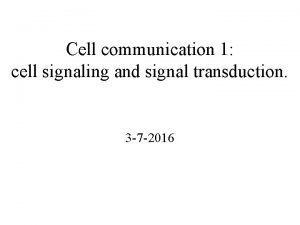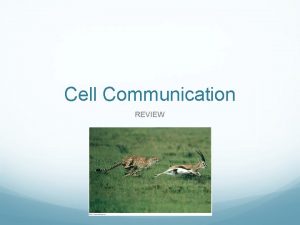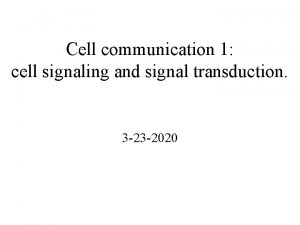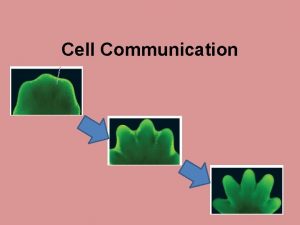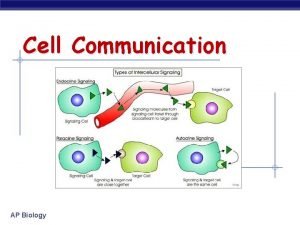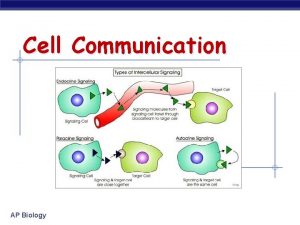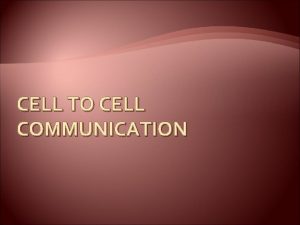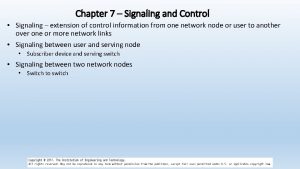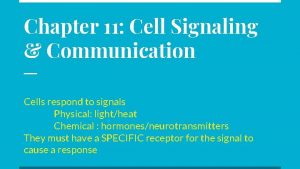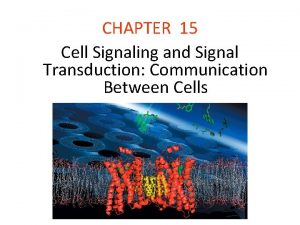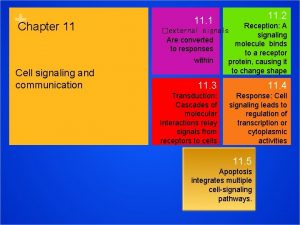Chapter 11 Cell Communication Evolution of Cell Signaling




































































- Slides: 68

Chapter 11 - Cell Communication

Evolution of Cell Signaling • A signal transduction pathway is a series of steps by which a signal on a cell’s surface is converted into a specific cellular response • Signal transduction pathways convert signals on a cell’s surface into cellular responses Copyright © 2008 Pearson Education, Inc. , publishing as Pearson Benjamin Cummings

The Three Stages of Cell Signaling: A Preview • Earl W. Sutherland discovered how the hormone epinephrine acts on cells • Sutherland suggested that cells receiving signals went through three processes: – Reception – Transduction – Response Copyright © 2008 Pearson Education, Inc. , publishing as Pearson Benjamin Cummings

Fig. 11 -6 -1 EXTRACELLULAR FLUID 1 Reception Receptor Signaling molecule CYTOPLASM Plasma membrane

Fig. 11 -6 -2 CYTOPLASM EXTRACELLULAR FLUID Plasma membrane 1 Reception 2 Transduction Receptor Relay molecules in a signal transduction pathway Signaling molecule

Fig. 11 -6 -3 CYTOPLASM EXTRACELLULAR FLUID Plasma membrane 1 Reception 2 Transduction 3 Response Receptor Activation of cellular response Relay molecules in a signal transduction pathway Signaling molecule

Concept 11. 2: Reception: A signal molecule binds to a receptor protein, causing it to change shape • The binding between a signal molecule (ligand) and receptor is highly specific • A shape change in a receptor is often the initial transduction of the signal • Most signal receptors are plasma membrane proteins Copyright © 2008 Pearson Education, Inc. , publishing as Pearson Benjamin Cummings

Receptors in the Plasma Membrane • Most water-soluble signal molecules bind to specific sites on receptor proteins in the plasma membrane • There are three main types of membrane receptors: – G protein-coupled receptors – Receptor tyrosine kinases – Ion channel receptors Copyright © 2008 Pearson Education, Inc. , publishing as Pearson Benjamin Cummings

• A G protein-coupled receptor is a plasma membrane receptor that works with the help of a G protein • The G protein acts as an on/off switch: If GDP is bound to the G protein, the G protein is inactive Copyright © 2008 Pearson Education, Inc. , publishing as Pearson Benjamin Cummings

Fig. 11 -7 a Signaling-molecule binding site Segment that interacts with G proteins G protein-coupled receptor

Fig. 11 -7 b Plasma membrane G protein-coupled receptor Activated receptor Signaling molecule GDP CYTOPLASM GDP Enzyme G protein (inactive) GTP 2 1 Activated enzyme GTP GDP Pi Cellular response 3 4 Inactive enzyme

• Receptor tyrosine kinases are membrane receptors that attach phosphates to tyrosines • A receptor tyrosine kinase can trigger multiple signal transduction pathways at once Copyright © 2008 Pearson Education, Inc. , publishing as Pearson Benjamin Cummings

Fig. 11 -7 c Ligand-binding site Signaling molecule (ligand) Signaling molecule Helix Tyrosines Tyr Tyr Tyr Tyr Tyr Receptor tyrosine kinase proteins CYTOPLASM Dimer 1 2 Activated relay proteins Tyr Tyr P P Tyr Tyr 6 ATP Activated tyrosine kinase regions 6 ADP Tyr P P P Tyr Tyr P P Fully activated receptor tyrosine kinase Inactive relay proteins 3 4 Cellular response 1 Cellular response 2

• A ligand-gated ion channel receptor acts as a gate when the receptor changes shape • When a signal molecule binds as a ligand to the receptor, the gate allows specific ions, such as Na+ or Ca 2+, through a channel in the receptor Copyright © 2008 Pearson Education, Inc. , publishing as Pearson Benjamin Cummings

Fig. 11 -7 d 1 Signaling molecule (ligand) Gate closed Ligand-gated ion channel receptor Ions Plasma membrane 2 Gate open Cellular response 3 Gate closed

Intracellular Receptors • Some receptor proteins are intracellular, found in the cytosol or nucleus of target cells • Small or hydrophobic chemical messengers can readily cross the membrane and activate receptors • Examples of hydrophobic messengers are the steroid and thyroid hormones of animals • An activated hormone-receptor complex can act as a transcription factor, turning on specific genes Copyright © 2008 Pearson Education, Inc. , publishing as Pearson Benjamin Cummings

Fig. 11 -8 -1 Hormone (testosterone) EXTRACELLULAR FLUID Plasma membrane Receptor protein DNA NUCLEUS CYTOPLASM

Fig. 11 -8 -2 Hormone (testosterone) EXTRACELLULAR FLUID Plasma membrane Receptor protein Hormonereceptor complex DNA NUCLEUS CYTOPLASM

Fig. 11 -8 -3 Hormone (testosterone) EXTRACELLULAR FLUID Plasma membrane Receptor protein Hormonereceptor complex DNA NUCLEUS CYTOPLASM

Fig. 11 -8 -4 Hormone (testosterone) EXTRACELLULAR FLUID Plasma membrane Receptor protein Hormonereceptor complex DNA m. RNA NUCLEUS CYTOPLASM

Fig. 11 -8 -5 Hormone (testosterone) EXTRACELLULAR FLUID Plasma membrane Receptor protein Hormonereceptor complex DNA m. RNA NUCLEUS CYTOPLASM New protein

Concept 11. 3: Transduction: Cascades of molecular interactions relay signals from receptors to target molecules in the cell • Signal transduction usually involves multiple steps • Multistep pathways can amplify a signal: A few molecules can produce a large cellular response • Multistep pathways provide more opportunities for coordination and regulation of the cellular response Copyright © 2008 Pearson Education, Inc. , publishing as Pearson Benjamin Cummings

Signal Transduction Pathways • The molecules that relay a signal from receptor to response are mostly proteins • Like falling dominoes, the receptor activates another protein, which activates another, and so on, until the protein producing the response is activated • At each step, the signal is transduced into a different form, usually a shape change in a protein Copyright © 2008 Pearson Education, Inc. , publishing as Pearson Benjamin Cummings

Protein Phosphorylation and Dephosphorylation • In many pathways, the signal is transmitted by a cascade of protein phosphorylations • Protein kinases transfer phosphates from ATP to protein, a process called phosphorylation Copyright © 2008 Pearson Education, Inc. , publishing as Pearson Benjamin Cummings

• Protein phosphatases remove the phosphates from proteins, a process called dephosphorylation • This phosphorylation and dephosphorylation system acts as a molecular switch, turning activities on and off Copyright © 2008 Pearson Education, Inc. , publishing as Pearson Benjamin Cummings

Fig. 11 -9 Signaling molecule Receptor Activated relay molecule Inactive protein kinase 1 Inactive protein kinase 2 ry ho sp o Ph Active protein kinase 1 de ca Inactive protein kinase 3 s ca PP n Pi P Active protein kinase 2 tio ADP la ATP ADP Pi Active protein kinase 3 PP Inactive protein P ATP P ADP Pi PP Active protein Cellular response

Small Molecules and Ions as Second Messengers • The extracellular signal molecule that binds to the receptor is a pathway’s “first messenger” • Second messengers are small, nonprotein, water-soluble molecules or ions that spread throughout a cell by diffusion • Second messengers participate in pathways initiated by G protein-coupled receptors and receptor tyrosine kinases • Cyclic AMP and calcium ions are common second messengers Copyright © 2008 Pearson Education, Inc. , publishing as Pearson Benjamin Cummings

Cyclic AMP • Cyclic AMP (c. AMP) is one of the most widely used second messengers • Adenylyl cyclase, an enzyme in the plasma membrane, converts ATP to c. AMP in response to an extracellular signal Copyright © 2008 Pearson Education, Inc. , publishing as Pearson Benjamin Cummings

Fig. 11 -10 Adenylyl cyclase Phosphodiesterase Pyrophosphate P ATP Pi c. AMP

• Many signal molecules trigger formation of c. AMP • Other components of c. AMP pathways are G proteins, G protein-coupled receptors, and protein kinases • c. AMP usually activates protein kinase A, which phosphorylates various other proteins • Further regulation of cell metabolism is provided by G-protein systems that inhibit adenylyl cyclase Copyright © 2008 Pearson Education, Inc. , publishing as Pearson Benjamin Cummings

Fig. 11 -11 First messenger Adenylyl cyclase G protein-coupled receptor GTP ATP c. AMP Second messenger Protein kinase A Cellular responses

Calcium Ions and Inositol Triphosphate (IP 3) • Calcium ions (Ca 2+) act as a second messenger in many pathways • Calcium is an important second messenger because cells can regulate its concentration Copyright © 2008 Pearson Education, Inc. , publishing as Pearson Benjamin Cummings

Fig. 11 -12 EXTRACELLULAR FLUID Plasma membrane Ca 2+ pump ATP Mitochondrion Nucleus CYTOSOL Ca 2+ pump Endoplasmic reticulum (ER) ATP Key High [Ca 2+] Low [Ca 2+] Ca 2+ pump

• A signal relayed by a signal transduction pathway may trigger an increase in calcium in the cytosol • Pathways leading to the release of calcium involve inositol triphosphate (IP 3) and diacylglycerol (DAG) as additional second messengers Animation: Signal Transduction Pathways Copyright © 2008 Pearson Education, Inc. , publishing as Pearson Benjamin Cummings

Fig. 11 -13 -1 EXTRACELLULAR FLUID Signaling molecule (first messenger) G protein DAG GTP G protein-coupled receptor Phospholipase C PIP 2 IP 3 (second messenger) IP 3 -gated calcium channel Endoplasmic reticulum (ER) CYTOSOL Ca 2+

Fig. 11 -13 -2 EXTRACELLULAR FLUID Signaling molecule (first messenger) G protein DAG GTP G protein-coupled receptor Phospholipase C PIP 2 IP 3 (second messenger) IP 3 -gated calcium channel Endoplasmic reticulum (ER) CYTOSOL Ca 2+ (second messenger)

Fig. 11 -13 -3 EXTRACELLULAR FLUID Signaling molecule (first messenger) G protein DAG GTP G protein-coupled receptor PIP 2 Phospholipase C IP 3 (second messenger) IP 3 -gated calcium channel Endoplasmic reticulum (ER) CYTOSOL Various proteins activated Ca 2+ (second messenger) Cellular responses

Concept 11. 4: Response: Cell signaling leads to regulation of transcription or cytoplasmic activities • The cell’s response to an extracellular signal is sometimes called the “output response” Copyright © 2008 Pearson Education, Inc. , publishing as Pearson Benjamin Cummings

Nuclear and Cytoplasmic Responses • Ultimately, a signal transduction pathway leads to regulation of one or more cellular activities • The response may occur in the cytoplasm or may involve action in the nucleus • Many signaling pathways regulate the synthesis of enzymes or other proteins, usually by turning genes on or off in the nucleus • The final activated molecule may function as a transcription factor Copyright © 2008 Pearson Education, Inc. , publishing as Pearson Benjamin Cummings

Fig. 11 -14 Growth factor Reception Receptor Phosphorylation cascade Transduction CYTOPLASM Inactive transcription factor Active transcription factor P Response DNA Gene NUCLEUS m. RNA

• Other pathways regulate the activity of enzymes Copyright © 2008 Pearson Education, Inc. , publishing as Pearson Benjamin Cummings

Fig. 11 -15 Reception Binding of epinephrine to G protein-coupled receptor (1 molecule) Transduction Inactive G protein Active G protein (102 molecules) Inactive adenylyl cyclase Active adenylyl cyclase (102) ATP Cyclic AMP (104) Inactive protein kinase A Active protein kinase A (104) Inactive phosphorylase kinase Active phosphorylase kinase (105) Inactive glycogen phosphorylase Active glycogen phosphorylase (106) Response Glycogen Glucose-1 -phosphate (108 molecules)

• Signaling pathways can also affect the physical characteristics of a cell, for example, cell shape Copyright © 2008 Pearson Education, Inc. , publishing as Pearson Benjamin Cummings

Fig. 11 -16 RESULTS Wild-type (shmoos) ∆Fus 3 ∆formin CONCLUSION 1 Mating factor G protein-coupled receptor Shmoo projection forming Formin P Fus 3 GDP GTP Phosphorylation cascade 2 Actin subunit P Formin P 4 Fus 3 P 3 Microfilament 5

Fig. 11 -16 a RESULTS Wild-type (shmoos) ∆Fus 3 ∆formin

Fig. 11 -16 b CONCLUSION 1 Mating factor G protein-coupled receptor Shmoo projection forming Formin P Fus 3 GDP GTP Phosphorylation cascade 2 Actin subunit P Formin P 4 Fus 3 P 3 Microfilament 5

Fine-Tuning of the Response • Multistep pathways have two important benefits: – Amplifying the signal (and thus the response) – Contributing to the specificity of the response Copyright © 2008 Pearson Education, Inc. , publishing as Pearson Benjamin Cummings

Signal Amplification • Enzyme cascades amplify the cell’s response • At each step, the number of activated products is much greater than in the preceding step Copyright © 2008 Pearson Education, Inc. , publishing as Pearson Benjamin Cummings

The Specificity of Cell Signaling and Coordination of the Response • Different kinds of cells have different collections of proteins • These different proteins allow cells to detect and respond to different signals • Even the same signal can have different effects in cells with different proteins and pathways • Pathway branching and “cross-talk” further help the cell coordinate incoming signals Copyright © 2008 Pearson Education, Inc. , publishing as Pearson Benjamin Cummings

Fig. 11 -17 Signaling molecule Receptor Relay molecules Response 1 Cell A. Pathway leads to a single response. Response 2 Response 3 Cell B. Pathway branches, leading to two responses. Activation or inhibition Response 4 Cell C. Cross-talk occurs between two pathways. Response 5 Cell D. Different receptor leads to a different response.

Fig. 11 -17 a Signaling molecule Receptor Relay molecules Response 1 Cell A. Pathway leads to a single response. Response 2 Response 3 Cell B. Pathway branches, leading to two responses.

Fig. 11 -17 b Activation or inhibition Response 4 Cell C. Cross-talk occurs between two pathways. Response 5 Cell D. Different receptor leads to a different response.

Signaling Efficiency: Scaffolding Proteins and Signaling Complexes • Scaffolding proteins are large relay proteins to which other relay proteins are attached • Scaffolding proteins can increase the signal transduction efficiency by grouping together different proteins involved in the same pathway Copyright © 2008 Pearson Education, Inc. , publishing as Pearson Benjamin Cummings

Fig. 11 -18 Signaling molecule Plasma membrane Receptor Scaffolding protein Three different protein kinases

Termination of the Signal • Inactivation mechanisms are an essential aspect of cell signaling • When signal molecules leave the receptor, the receptor reverts to its inactive state Copyright © 2008 Pearson Education, Inc. , publishing as Pearson Benjamin Cummings

Concept 11. 5: Apoptosis (programmed cell death) integrates multiple cell-signaling pathways • Apoptosis is programmed or controlled cell suicide • A cell is chopped and packaged into vesicles that are digested by scavenger cells • Apoptosis prevents enzymes from leaking out of a dying cell and damaging neighboring cells Copyright © 2008 Pearson Education, Inc. , publishing as Pearson Benjamin Cummings

Fig. 11 -19 2 µm

Apoptosis in the Soil Worm Caenorhabditis elegans • Apoptosis is important in shaping an organism during embryonic development • The role of apoptosis in embryonic development was first studied in Caenorhabditis elegans • In C. elegans, apoptosis results when specific proteins that “accelerate” apoptosis override those that “put the brakes” on apoptosis Copyright © 2008 Pearson Education, Inc. , publishing as Pearson Benjamin Cummings

Fig. 11 -20 Ced-9 protein (active) inhibits Ced-4 activity Mitochondrion Ced-4 Receptor for deathsignaling molecule Ced-3 Inactive proteins (a) No death signal Ced-9 (inactive) Cell forms blebs Deathsignaling molecule Active Ced-4 Ced-3 Activation cascade (b) Death signal Other proteases Nucleases

Fig. 11 -20 a Ced-9 protein (active) inhibits Ced-4 activity Mitochondrion Receptor for deathsignaling molecule Ced-4 Ced-3 Inactive proteins (a) No death signal

Fig. 11 -20 b Ced-9 (inactive) Cell forms blebs Deathsignaling molecule Active Ced-4 Ced-3 Activation cascade (b) Death signal Other proteases Nucleases

Apoptotic Pathways and the Signals That Trigger Them • Caspases are the main proteases (enzymes that cut up proteins) that carry out apoptosis • Apoptosis can be triggered by: – An extracellular death-signaling ligand – DNA damage in the nucleus – Protein misfolding in the endoplasmic reticulum Copyright © 2008 Pearson Education, Inc. , publishing as Pearson Benjamin Cummings

• Apoptosis evolved early in animal evolution and is essential for the development and maintenance of all animals • Apoptosis may be involved in some diseases (for example, Parkinson’s and Alzheimer’s); interference with apoptosis may contribute to some cancers Copyright © 2008 Pearson Education, Inc. , publishing as Pearson Benjamin Cummings

Fig. 11 -21 Interdigital tissue 1 mm

Fig. 11 -UN 1 1 Reception 2 Transduction 3 Response Receptor Relay molecules Signaling molecule Activation of cellular response

Fig. 11 -UN 2

You should now be able to: 1. Describe the nature of a ligand-receptor interaction and state how such interactions initiate a signal-transduction system 2. Compare and contrast G protein-coupled receptors, tyrosine kinase receptors, and ligandgated ion channels 3. List two advantages of a multistep pathway in the transduction stage of cell signaling 4. Explain how an original signal molecule can produce a cellular response when it may not even enter the target cell Copyright © 2008 Pearson Education, Inc. , publishing as Pearson Benjamin Cummings

5. Define the term second messenger; briefly describe the role of these molecules in signaling pathways 6. Explain why different types of cells may respond differently to the same signal molecule 7. Describe the role of apoptosis in normal development and degenerative disease in vertebrates Copyright © 2008 Pearson Education, Inc. , publishing as Pearson Benjamin Cummings
 3 types of cell signaling
3 types of cell signaling Chemical signalling
Chemical signalling Dot
Dot 3 stages of cell communication
3 stages of cell communication Exocrine cell signaling
Exocrine cell signaling Cell signaling
Cell signaling Cell signaling overview
Cell signaling overview Pdi cell signaling
Pdi cell signaling Chapter 48 neurons synapses and signaling
Chapter 48 neurons synapses and signaling Chapter 48 neurons synapses and signaling
Chapter 48 neurons synapses and signaling Introductory words and phrases signals
Introductory words and phrases signals Reiteration in discourse analysis
Reiteration in discourse analysis Register and signaling vocabulary
Register and signaling vocabulary What action is the ground guide signaling?
What action is the ground guide signaling? Ligand signaling molecule
Ligand signaling molecule Signaling system 7
Signaling system 7 Autocrine and juxtacrine signaling
Autocrine and juxtacrine signaling Autocrine and juxtacrine signaling
Autocrine and juxtacrine signaling Chemical signaling
Chemical signaling Phosphorylation cascade
Phosphorylation cascade Chemical signaling
Chemical signaling Chemical signaling
Chemical signaling Most embryonic industries emerge from:
Most embryonic industries emerge from: The process of intentionally or unintentionally signaling
The process of intentionally or unintentionally signaling Scp 3710
Scp 3710 Use visual signaling techniques
Use visual signaling techniques Evolution of satellite technology
Evolution of satellite technology Evolution of wireless communication
Evolution of wireless communication Chapter 11 cell communication
Chapter 11 cell communication Chapter 4 cell theory and cell study
Chapter 4 cell theory and cell study Chapter 16 evolution of populations vocabulary review
Chapter 16 evolution of populations vocabulary review Chapter 17 evolution of populations answer key
Chapter 17 evolution of populations answer key Strengths and weaknesses of evolutionary theory page 386
Strengths and weaknesses of evolutionary theory page 386 Chapter 7 the evolution of living things answers
Chapter 7 the evolution of living things answers Chapter 5 evolution and community ecology
Chapter 5 evolution and community ecology Chapter 23 the evolution of populations
Chapter 23 the evolution of populations Chapter 21 section 1 plant evolution and adaptations
Chapter 21 section 1 plant evolution and adaptations Chapter 18 the evolution of invertebrate diversity
Chapter 18 the evolution of invertebrate diversity Chapter 18 genomes and their evolution
Chapter 18 genomes and their evolution Chapter 17 darwins theory of evolution
Chapter 17 darwins theory of evolution Chapter 16 section 1 primates study guide answers
Chapter 16 section 1 primates study guide answers Chapter 16 evolution of populations
Chapter 16 evolution of populations Chapter 15 darwin's theory of evolution section 15-1
Chapter 15 darwin's theory of evolution section 15-1 Chapter 15 darwin's theory of evolution section 15-1
Chapter 15 darwin's theory of evolution section 15-1 Chapter 6 the evolution of exteriors
Chapter 6 the evolution of exteriors Chapter 6 the evolution of exteriors
Chapter 6 the evolution of exteriors Chapter 23 the evolution of populations
Chapter 23 the evolution of populations Introduction to evolution of management
Introduction to evolution of management Chapter 16 primate evolution
Chapter 16 primate evolution Chapter 5 evolution and community ecology
Chapter 5 evolution and community ecology Chapter 5 evolution and community ecology answer key
Chapter 5 evolution and community ecology answer key Chapter 4 biodiversity and evolution
Chapter 4 biodiversity and evolution Chapter 21 section 1 plant evolution and adaptations
Chapter 21 section 1 plant evolution and adaptations Molecular biology evidence of evolution
Molecular biology evidence of evolution Advanced evolution - chapter 4
Advanced evolution - chapter 4 Advanced evolution chapter 4
Advanced evolution chapter 4 Advanced evolution chapter 8
Advanced evolution chapter 8 Natural selection
Natural selection Chapter 24 animal evolution diversity and behavior
Chapter 24 animal evolution diversity and behavior Chapter 7 the evolution of living things answers
Chapter 7 the evolution of living things answers Chapter 14 evolution a history and a process
Chapter 14 evolution a history and a process Serial vs parallel ports
Serial vs parallel ports What is oral communication and written communication
What is oral communication and written communication Serial and parallel communication
Serial and parallel communication What is mass communication
What is mass communication Diff between oral and written communication
Diff between oral and written communication Serial communication vs parallel communication
Serial communication vs parallel communication Cell dragging in mobile communication
Cell dragging in mobile communication Cell communication types
Cell communication types
